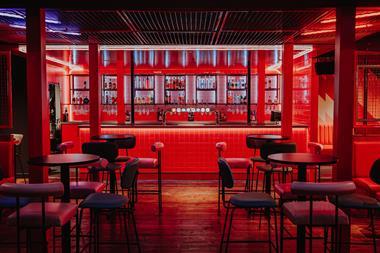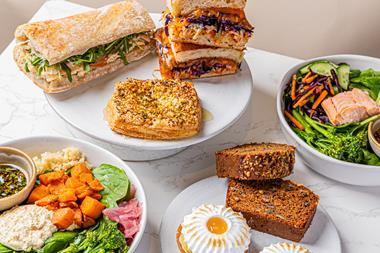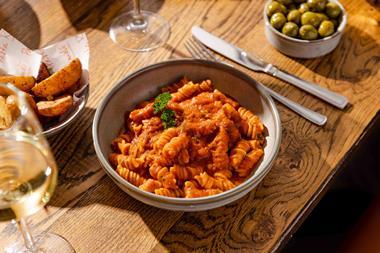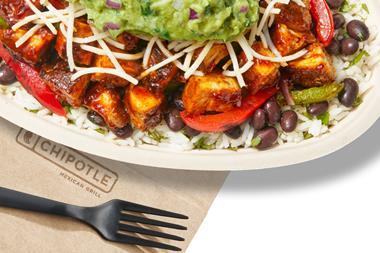In a career spanning three decades, Grainne Allen has worked across all the major pillars of the food industry. What began as a placement year with Marks & Spencer turned into a full-time position as one of the retailer’s first graduate product developers.
Since then, Allen has been involved in several major projects, from pioneering healthy ready meals to rewriting the culinary strategy for the Taste the Difference range at Sainsbury’s. In 2018, she joined Whitbread as head of food and beverage, overseeing the menu development at its 850 restaurants, from Brewers Fayre pubs to Bar + Block steakhouses.
“All our Whitbread restaurants are attached to a Premier Inn but also have a local audience, so it’s very difficult to define the set demographic,” she tells Food Spark. “It’s much more important that we define the need in terms of whether you’re staying in our [Premier Inn] hotel and want to come and eat on your own, versus if you’re a family coming out for an everyday meal within a budget that’s affordable, versus those celebrating a special occasion.”
There’s a lot of detail involved in compiling information about these different needs – there are even statistics on the number of people who ask their other halves to marry them at a Brewers Fayre.
Allen and her team shepherd menu changes from ideation and development to chef training, ensuring dishes are delivered according to spec. “It’s end to end, from working with procurement on the sourcing and the right supplier, right through to what lands on the customer’s plate,” she explains, adding that she even gets involved in dish styling and photography.
One of her focuses most recently has been on the development of next-generation Beefeater, updating the steak experience and offering more enticing healthy options. Part of this evolution is being based on research into Generation Z (as part of her teaching role at Ulster University Business School, where she has been a visiting professor since 2011, Allen worked with final years to discover what this age group considered most important when it came to meals).
“Instagramability was right up there – in some respects it had to look great first and foremost before they tasted it,” notes Allen. “[Gen Z] are not drinking a lot of alcohol either, so it’s about how do you get interested in drinks that are low alcohol.”
Here, she talks about initiating allergen initiatives and making theatre out of familiar ingredients.
I launched the first healthy ready meal in the country. It was called Healthy Choice and it was a salmon in light cream sauce. I remember everybody at the time being a little bit sceptical. My husband was on a diet and, one day, I got home and he had bought these frozen Lean Cuisine meals. I remember looking at them in absolute horror, thinking, oh my god – we can do better than these!
As Marks & Spencer we could deliver delicious ready meals that were calorie controlled. With a couple of great colleagues, we wrote the first nutrition policy that probably existed in this country. And that range went on to grow and grow and eventually got rebranded to Count On Us and developed further from there.
The other big project I did was the re-launch of Covent Garden Soup. It had been around for a few years but it had got very tired, and I got asked to come in and help them redevelop those soups. At that time it was one of the top 10 known brands in this country and yet it was fading back… We did loads of consumer testing and redevelopment. I sought out the engineer and spent time understanding the kit and possibilities. To get done what I needed to get done, I needed the engineer – they should always be the developer’s best friend!
At Whitbread we’ve got a broad portfolio of restaurants. We have Bar + Block, which is very much about our authority in steak. We have Brewers Fayre, which is more targeted at family and has got a big local audience. We have Beefeater, which is steak and grill and has a slightly more affluent, modern family approach to it. And then we have various other food initiatives such as our new Zip hotel formats, which is much more about convenience and how quickly people want to be able to move through.
The different brands are very defined. But even within that, depending on the demographics you might have slightly different need states. That’s where getting a universal appeal of menu is super important, delivering great quality at great value.
When we work with guests to understand what it is they want, whether it’s everyday dining or comfort treating, it comes back to those key ingredients that they love. So how do we deliver that in a special way that has a little bit more theatre?
If you look at our new chocolate bomb, it’s basically a chocolate shell with brownie and ice cream in it, and you pour over the hot chocolate and then it melts down. For us, that’s great innovation; for our guests, they love it because it’s theatre at the table. The universal appeal is that it’s chocolate brownie, it’s vanilla ice cream, it’s chocolate sauce, it’s got a simple crumb on it, there’s nothing not to love.
With our desserts, it’s all about the art of chocolate. That’s where the bomb started – what if we took chocolate as the subject and really thought about it? Yes, we will still offer fruit and sundaes and all those things that are loved, but how do we move this on? What’s important in our restaurants is to take our guests on a half-step, not a leap, because if we take them on a leap, we’ll lose them, they’ll feel that it’s not accessible.
In retail, the future is going to be about how you can bring experience. It’s no different in restaurants, actually, because for people to go out to a restaurant rather than call up Deliveroo or Just Eat it’s got to be about more than just great quality food; it’s also got to be that there is an experience in the food and the environment.
Generation Z are a very different generation that are coming through, and I think it’s super important that I keep watching that generation, because they are the restaurant visitors of the future, our guests of the future. They are our guests now, but how they then grow and become families – it’s going to be interesting to see how we evolve.
Our next-generation Beefeater is really about four key things. 1. The steak experience: having great quality steaks and how we deliver that in a slightly different way, whether it be sampler platters or sharing knowledge. 2. The art of the grill: we have these state-of-the-art grills that are award winning for their environmental impact; we’ve been changing all our grills across all our Beefeaters, and the art of cooking on a piece of tech like that is really interesting – how else do we maximise that with fish and vegetables? 3. Naturally healthier ways of eating: health is everywhere, we can’t ignore it, so what are the great swap ins and swap outs that we can offer – for example, a bowl of lovely grilled vegetables versus a bowl of chips, how can we make that appealing, because the natural reaction is to go for the bowl of chips? 4. Modernising the sides that we offer: I think we always had a very boring salad, but simple things like adding a great parmesan and rocket salad, or a great tomato salad, can go well with steak.
One of the areas that our guests love are mixed grills, so what we have been working on for next summer is taking the concept of mixed grill – which can look a little bit like it’s stayed in the 1970s – and bringing that up to date.
The health angle that guests want now compared to 25 years ago is the whole understanding of how sugar links to weight management and the crisis in diabetes. There’s also the whole vegan and vegetarian piece – whether it be dirty vegan or clean vegan.
We talk a lot about inclusive choice. If you’ve got a big family gathering or a group gathering, the vegan within that group could have the veto vote, because if we don’t offer something that’s delicious for them, they’ll say, ‘Well, I can’t eat here,’ so everybody will leave.
Eating healthier needs to be more about consumer choice. For example, whether they want to have a small portion on their desserts – we have our mini desserts for those who want something sweet at the end of the meal but don’t want to bust the calories.
We’ve been working hard to reduce all the sugar in the desserts. We’ve done an awful lot on that and we’re well on our way to hitting our 2020 government targets. We work with the Out of Home Alliance and are in regular contact with PHE on that detail. I brought in with me a company nutritionist and she helps us navigate that and works with the chefs to make that tangible.
On desserts, just last year we said, ‘Let’s just take 5% more sugar out to see what they taste like, because, actually, do we need that much sugar?’ We did a blind tasting and, honestly, the flavour was coming through better with less sugar. You’d get the raspberry through, you’d get the chocolate through.
You can’t go back dramatically because it won’t taste right and because sugar is key in the safety of some products as well. But what we’re actively doing is questioning every dish, saying, ‘Could that be baked rather than fried?’ At the front end, the guest would never know that we had actively been thinking about those things. It’s not compromising taste, but in the background we’re asking, ‘Do we really need that much sugar or to fry that?’
We’re not a nanny state as a restaurant, but equally guests can swap out and have a salad or something a bit healthier if they want.
If you come into a restaurant and you have an allergy, we have a very clear set of steps our teams go through to handle your order. But we always say we have open kitchens, air-borne cross-contamination for example is a risk, so if you’re highly anaphylactic we’d rather disappoint you than have you ill – we’re very clear on that. But if it’s an intolerance or less severe, it’s the guest’s choice and our teams will follow the operative procedures in place to protect our guests.
We have a full book on each site where you can check the allergen details of every single ingredient that we have, and we’re looking at better methods of doing that as well that are quicker and more efficient for the future… It’s a big book as you can imagine! We would like to go digital – we’re looking at various apps related to that. Before we change what we do, we’re going to run some research with allergy sufferers to find out what is the most helpful thing for them.
We do a constant train on [allergies]. As we change out the menus, we’ll reemphasise the policy on allergy management. There’s a clear process, so if you’re in a restaurant and you have an allergy, your order will be taken by the most senior member of the team; it will then be directed through into the kitchen that there’s an allergy sufferer and special handling is put in place to endeavour to ringfence all the detail.
We should play to the fad of the moment so it gives guests the opportunity to try it… I think fads bring light and shade to what we do. If there are things that are interesting, why not? It’s like fashion: just because this is the ‘in’ colour this year and it might not be next year, so what? Let’s wear it this year! If it sparks one person to be more interested in food than they were the day before, why not? I love it, bring it on!
If 80% of [our food development] is a drumbeat further ahead, how do we fast track these moments that are about getting something that guests want to try right now? There is a bit of bravery about doing that in a big world like this, saying, actually, let’s just play into this for a second. I’m all for it, I’m all for that moment that might just be a month in the summer that gives guests a reason to believe that we’re in tune with them, that we’re seeing what’s popular at the moment and giving them the opportunity to try it in a safe environment, delivered well.
- The full version of this article was originally published on foodspark.com, a digital subscription covering innovation across the food industry. For more information or to request a demo, contact: joinus@foodspark.com or 01293 610371.
Precis
FOOD SPARK
Whitbread’s Grainne Allen: Our restaurants are not a nanny state
The head of food & beverage at the Brewers Fayre and Bar + Black operator shares insights on the next generation Beefeater steakhouse, making theatre out of everyday ingredients, reducing sugar without sacrificing flavour and attracting that illusive younger demographic.



























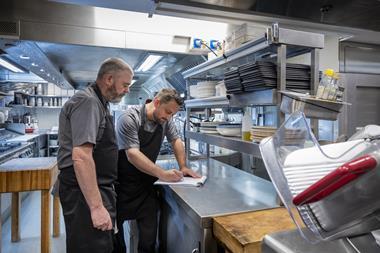
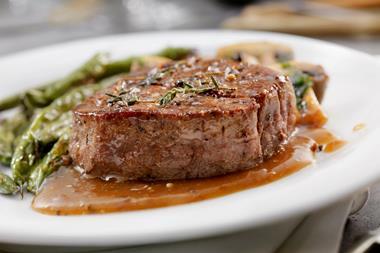

![Bar + Block interiors[78]](https://d36hgjhwuw81py.cloudfront.net/Pictures/380x253/4/5/8/343458_barblockinteriors78_101429.jpg)
